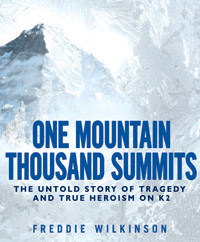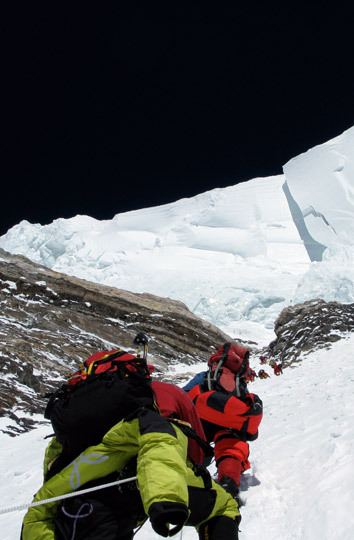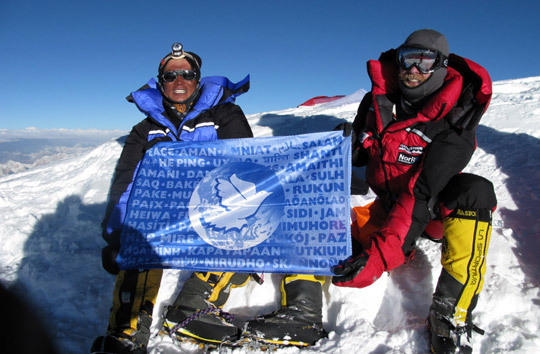
One Mountain Thousand Summits: The Untold Story of Tragedy and True Heroism on K2
By Freddie Wilkinson
$24.95, New American Library, hardcover, 352 pages.
K2 has been called the deadliest mountain in the world. For every four climbers who reach its summit, one dies on its slopes.
In the wee hours of the morning on August 1, 2008, members of climbing teams from across the globe–Serbia, Denmark, South Korea and elsewhere–emerged slowly from their tents at their 7800-meter high camp. They donned marshmallowy down suits and strapped on crampons. It was summit day on K2.
One by one, the climbers trickled out of Camp 4, just behind the team that would fix ropes through the Bottleneck. The most dangerous part of the climb, the Bottleneck is a steep, narrow couloir positioned under a serac, 400 meters below the summit on the Abruzzi Spur. Climbers worked their way, slowly but steadily, up the snowfields until they reached the Bottleneck, where a queue of people had formed at the fixed lines. That’s when things started to go wrong. Serbian climber Dren Mandic fell to his death when he unclipped from the fixed lines trying to pass a sluggish climber in front of him. In an attempt to transport Mandic’s body back to Camp 4, high-altitude porter Jahan Baig slipped and fell, disappearing over the edge of a precipice. His body was never recovered. Later that night, a swarm of 12 climbers returning from a late summit push was trapped on the upper reaches of the Bottleneck when an avalanche of ice stripped the fixed lines, and Rolf Bae, from the couloir. Only four survived.
As a result, high-altitude mountaineering made a sensational appearance on the world stage. Mainstream media–including CNN, the BBC and Al Jazeera–picked up the story, broadcasting flurries of vague and often inaccurate reports about the happenings on K2. The media bombarded the climbing community with criticism and made hasty comparisons between the unfolding tragedy on K2 and the 1996 Mt. Everest disaster, in which a violent storm and the hubris of expedition leaders brought about the deaths of eight climbers, many of whom were inexperienced and ill-equipped.
One Mountain Thousand Summits is a well reasoned and almost defiant response to those poorly researched reports and muddled conclusions.
Author and accomplished climber Freddie Wilkinson was not on K2 when tragedy struck, but it is clear from Chapter One that his story is painstakingly researched. Through scores of sources–from countless email, phone and in-person interviews to the last five coordinates taken from a missing climber’s satellite phone–Wilkinson seeks to expose and rectify the many misconceptions perpetuated by hasty reporting and foggy testimonies from the climbers themselves.

Climbers navigate the Bottleneck, the most dangerous section of K2’s normal route, where eleven climbers died in August 2008. [Photo] Chris Klinke / Goalexploration.com
The book provides a minute-by-minute account of the events on the mountain, as well as that of the experiences of teammates and loved ones sitting at their computers, desperately scouring the Internet for news. This narrative of the incident is punctuated by gracefully human profiles of the people involved, both surviving and deceased. Wilkinson morphs the tale into more than a simple report of a distant tragedy through these portraits. The avalanche of personal loss and resulting self-reflection is made tangible through Wilkinson’s expert character development and shrewd insight into a complex situation. Much of the information behind these profiles is a collection of Wilkinson’s own interaction with climbers and their family members. The author’s first-person descriptions of their interactions serve a dual-purpose. His insightful observations morph the faceless players in this far-away tragedy into unique and interesting people. Wilkinson’s explication of these interactions also validates his investigation of the event and the conclusions he draws from it.

Pemba Gyalje and Gerard McDonnell on the summit of K2 (8611m), Karakoram, Pakistan [Photo] Gerard McDonnell
The book is organized into three parts. The first offers a play-by-play of the events unfolding on the mountain and an introduction to the characters–both on the mountain and off. It also lays out a wealth of information that gives the reader a basic knowledge of everything from K2’s climbing history to the use of satellite phones in modern mountaineering to the signs, symptoms and treatment for hypoxia.
Part Two examines the role of sherpas and high-altitude porters in the climbing world, centering the majority of his analysis on the dynamics of the 2008 K2 expeditions. Wilkinson gives voice to the experiences of sherpas Chhiring Dorje and Pemba Gyalje, whose experiences were overwhelmingly ignored by mainstream media, but who played important roles in the outcome of the events that August.
The discussions featured in Part Three center around Gerard McDonnell, an Irish climber and member of the Dutch Norit Expedition who died on K2. Little is known about McDonnell’s experience during the disaster and much of this section is devoted to research and speculation regarding his fate. In the end, Wilkinson reluctantly draws his own conclusions about the climber, using photos and the testimonies of other climbers to piece together McDonnell’s final hours.
The organization of One Mountain Thousand Summits allows for a discussion of the events on K2 themselves, pertinent history, expedition politics and climbing ethics. It also allows ample room for Wilkinson to tackle issues that previous investigators of the tragedy failed to discuss, such as the courageous actions of Dorje and Gyalje and the mystery of Gerard McDonnell’s fate.
While some readers may be familiar with the events, those less savvy will be frustrated by the shifting narrative. Wilkinson changes his focus continually, jumping from topic to topic. In Chapter Two alone, he details the challenges of high-altitude mountaineering, sets a chaotic scene as the avalanche of ice sweeps down the Bottleneck, describes the angst of family members waiting for news at their homes all over the world and examines the use and history of satellite phones in the alpine realm, with little transition in between. While each snippet contributes to the broader story, the choppy account can be confusing–and a tease. Often I would read one of these fascinating segments and lust for more details that never came.
However, these abrupt changes do not spoil Wilkinson’s meticulous research, obvious devotion to accuracy and unbridled creativity. The gritty oeuvre is not only intensely captivating, but also the most comprehensive and introspective account of the disastrous events that took place on K2 two summers ago.
Learn more about the 2008 tragedies on K2 in the Alpinist NewsWires; August 1, August 4, August 5, August 7 and August 18, 2008.